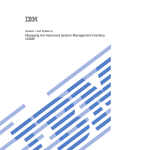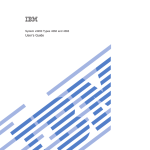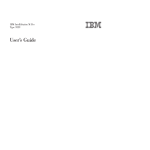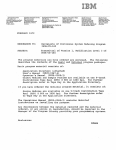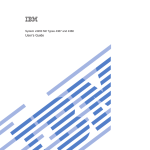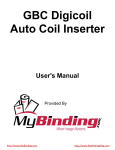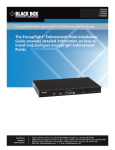Download 4764 PCI-X Cryptographic Coprocessor Installation Manual
Transcript
4764 PCI-X Cryptographic Coprocessor Installation Manual Note Before using this information and the product it supports, read the information in “Safety and environmental notices” on page ix and in “Notices,” on page 11. Third Edition, September 2008 This edition describes installation of the IBM® 4764 PCI-X Cryptographic Coprocessor. IBM does not stock publications at the address given below. This and other publications related to the IBM 4764 Cryptographic Coprocessor can be obtained in PDF format from www.ibm.com/security/cryptocards. Readers’ comments can be communicated to IBM by using the support link on the product Web site at http://www.ibm.com/security/cryptocards, or by sending a letter to: IBM Corporation Department VM9A, MG81 Security Solutions and Technology 8501 IBM Drive Charlotte, NC 28262-8563 USA When you send information to IBM, you grant IBM a nonexclusive right to use or distribute the information in any way it believes appropriate without incurring any obligation to you. ©Copyright International Business Machines Corporation 2005, 2008. All rights reserved. US Government Users Restricted Rights - Use, duplication or disclosure restricted by GSA ADP Schedule Contract with IBM Corp. Contents Figures . . . . . . . . . . . . . . . . . . . . . . . . . . . . . . . . . . . . v Tables . . . . . . . . . . . . . . . . . . . . . . . . . . . . . . . . . . . . vii Safety and environmental notices . . . . . . . . . . . . . . . . . . . . . . . . . . ix Safety notices . . . . . . . . . . . . . . . . . . . . . . . . . . . . . . . . . . ix World trade safety information . . . . . . . . . . . . . . . . . . . . . . . . . . . . x Environmental notices . . . . . . . . . . . . . . . . . . . . . . . . . . . . . . . xi Product recycling and disposal . . . . . . . . . . . . . . . . . . . . . . . . . . . xi Battery return program . . . . . . . . . . . . . . . . . . . . . . . . . . . . . . . xii IBM cryptographic coprocessor card return program . . . . . . . . . . . . . . . . . . . . xiii About this manual. . . . . . . . . . . . . . . . . . . . . . . . . . . . . . . . xv How this manual is organized . . . . . . . . . . . . . . . . . . . . . . . . . . . . xv Where to find more information . . . . . . . . . . . . . . . . . . . . . . . . . . . xv Chapter 1. Introduction . . . . . . . . . Contents of the coprocessor package . . . . Special considerations for handling and storage . Temperature . . . . . . . . . . . . . Batteries . . . . . . . . . . . . . . Requirements and specifications . . . . . . Hardware requirement . . . . . . . . . Software requirement . . . . . . . . . Power requirement . . . . . . . . . . Environmental specifications . . . . . . . Physical dimensions . . . . . . . . . . . . . . . . . . . . . . . . . . . . . . . . . . . . . . . . . . . . . . . . . . . . . . . . . . . . . . . . . . . . . . . . . . . . . . . . . . . . . . . . . . . . . . . . . . . . . . . . . . . . . . . . . . . . . . . . . . . . . . . . . . . . . . . . . . . . . . . . . . . . . . . . . . . . . . . . . . . . . . . . . . . . . . . . . . . . . . . . . . . . . . . . . . . . . . . . . . . . . . . . . . . . . . . . . . . . . . . . . . . . . . . . . . . . . . . . . 1 1 1 1 1 2 2 2 2 2 2 Chapter 2. Installing the coprocessor . . . . . . . . . . . . . . . . . . . . . . . . . 3 Chapter 3. Replacing IBM PCI-X cryptographic coprocessor batteries . . . . . . . . . . . . 7 Appendix. Notices . . . . . . . . . . . . . . . . . . . . Trademarks . . . . . . . . . . . . . . . . . . . . . . Electronic emissions . . . . . . . . . . . . . . . . . . . Federal Communications Commission (FCC) statement . . . . . Industry Canada compliance statement . . . . . . . . . . . Avis de conformité aux normes d’Industrie Canada . . . . . . . Japanese Voluntary Control Council for Interference (VCCI) statement . . . . . . . . . . . . . . . . . . . . . . . . . . . . . . . . . . . . . . . . . . . . . . . . . . . . . . . . . . . . . . . . . . . . . . . . . . . . . . . . . . . . 11 12 12 12 13 13 13 Glossary . . . . . . . . . . . . . . . . . . . . . . . . . . . . . . . . . . . 15 Index . . . . . . . . . . . . . . . . . . . . . . . . . . . . . . . . . . . . . 17 iii iv 4764 PCI-X Cryptographic Coprocessor Installation Manual Figures 1. 2. 3. Jumpers on the PCI-X cryptographic coprocessor (front side) . . . . . . . . . . . . . . . 4 Jumpers on the PCI-X cryptographic coprocessor (back side) . . . . . . . . . . . . . . . 5 J10 connector and battery locations on the PCI-X cryptographic coprocessor . . . . . . . . . 9 v vi 4764 PCI-X Cryptographic Coprocessor Installation Manual Tables 1. 2. Operating, storage, and shipping specifications . . . . . . . . . . . . . . . . . . . . 2 Jumpers on the PCI-X cryptographic coprocessor . . . . . . . . . . . . . . . . . . . 5 vii viii 4764 PCI-X Cryptographic Coprocessor Installation Manual Safety and environmental notices Safety notices Safety notices may be printed throughout this guide. DANGER notices warn you of conditions or procedures that can result in death or severe personal injury. CAUTION notices warn you of conditions or procedures that can cause personal injury that is neither lethal nor extremely hazardous. Attention notices warn you of conditions or procedures that can cause damage to machines, equipment, or programs. The following DANGER notice appears in this manual: DANGER Electrical voltage and current from power, telephone, and communication cables are hazardous. To avoid a shock hazard: v Do not connect or disconnect any cables or perform installation, maintenance, or reconfiguration of this product during an electrical storm. v Connect all power cords to a properly wired and grounded electrical outlet. Ensure outlet supplies proper voltage and phase rotation according to the system rating plate. v Connect any equipment that will be attached to this product to properly wired outlets. v When possible, use one hand only to connect or disconnect signal cables. v Never turn on any equipment when there is evidence of fire, water, or structural damage. v Disconnect the attached power cords, telecommunications systems, networks, and modems before you open the device covers, unless instructed otherwise in the installation and configuration procedures. v Connect and disconnect cables as described below when installing, moving, or opening covers on this product or attached devices. To Disconnect: 1. Turn everything OFF (unless instructed otherwise). 2. Remove power cords from the outlet. 3. Remove signal cables from connectors. 4. Remove all cables from devices. To Connect: 1. Turn everything OFF (unless instructed otherwise) 2. Attach all cables to devices. 3. Attach signal cables to connectors. 4. Attach power cords to outlet. 5. Turn device ON. (D005) ix The following CAUTION notice appears in this manual: CAUTION: Only trained service personnel may replace this battery. The battery contains lithium. To avoid possible explosion, do not burn or charge the battery. Do Not: __ Throw or immerse into water __ Heat to more than 100°C (212°F) __ Repair or disassemble Exchange only with the IBM-approved part. Recycle or discard the battery as instructed by local regulations. In the United States, IBM has a process for the collection of this battery. For information, call 1-800-426-4333. Have the IBM part number for the battery unit available when you call. (C002) World trade safety information Several countries require the safety information contained in product publications to be presented in their national languages. If this requirement applies to your country, a safety information booklet is included in the publications package shipped with the product. The booklet contains the safety information in your national language with references to the US English source. Before using a US English publication to install, operate, or service this IBM product, you must first become familiar with the related safety information in the booklet. You should also refer to the booklet any time you do not clearly understand any safety information in the US English publications. x 4764 PCI-X Cryptographic Coprocessor Installation Manual Environmental notices Product recycling and disposal This unit must be recycled or discarded according to applicable local and national regulations. IBM encourages owners of information technology (IT) equipment to responsibly recycle their equipment when it is no longer needed. IBM offers a variety of product return programs and services in several countries to assist equipment owners in recycling their IT products. Information on IBM product recycling offerings can be found on IBM’s Internet site at: | http://www.ibm.com/ibm/environment/products/index.shtml. | | | | | | Esta unidad debe reciclarse o desecharse de acuerdo con lo establecido en la normativa nacional o local aplicable. IBM a los propietarios de equipos de tecnología de la información (TI) que reciclen responsablemente sus equipos cuando éstrecomiendaos ya no les sean útiles. IBM dispone de una serie de programas y servicios de devolución de productos en varios países, a fin de ayudar a los propietarios de equipos a reciclar sus productos de TI. Se puede encontrar información sobre las ofertas de reciclado de productos de IBM en el sitio web de IBM | http://www.ibm.com/ibm/environment/products/index.shtml. Notice: This mark applies only to countries within the European Union (EU) and Norway. Appliances are labeled in accordance with European Directive 2002/96/EC concerning waste electrical and electronic equipment (WEEE). The Directive determines the framework for the return and recycling of used appliances as applicable throughout the European Union. This label is applied to various products to indicate that the product is not to be thrown away, but rather reclaimed upon end of life per this Directive. In accordance with the European WEEE Directive, electrical and electronic equipment (EEE) is to be collected separately and to be reused, recycled, or recovered at end of life. Users of EEE with the WEEE marking per Annex IV of the WEEE Directive, as shown above, must not dispose of end of life EEE as unsorted municipal waste, but use the collection framework available to customers for the return, recycling, and recovery of WEEE. Customer participation is important to minimize any potential effects of EEE on the environment and human health due to the potential presence of hazardous substances in EEE. For proper collection and treatment, contact your local IBM representative. For the European Union: Safety and environmental notices xi Battery return program | | | | | This product may contain sealed lead acid, nickel cadmium, nickel metal hydride, lithium, or lithium ion battery(s). Consult your user manual or service manual for specific battery information. The battery must be recycled or disposed of properly. Recycling facilities may not be available in your area. For information on disposal of batteries outside the United States, go to http://www.ibm.com/ibm/environment/products/ index.shtml or contact your local waste disposal facility. | | | | In the United States, IBM has established a return process for reuse, recycling, or proper disposal of used IBM sealed lead acid, nickel cadmium, nickel metal hydride, and other battery packs from IBM Equipment. For information on proper disposal of these batteries, contact IBM at 1-800-426-4333. Please have the IBM part number listed on the battery available prior to your call. | In Taiwan, the following applies: | | | Please recycle batteries | | | | | Notice: This mark applies only to countries within the European Union (EU) and Norway. | | | | | Batteries or packaging for batteries are labeled in accordance with European Directive 2006/66/EC concerning batteries and accumulators and waste batteries and accumulators. The Directive determines the framework for the return and recycling of used batteries and accumulators as applicable throughout the European Union. This label is applied to various batteries to indicate that the battery is not to be thrown away, but rather reclaimed upon end of life per this Directive. | | xii 4764 PCI-X Cryptographic Coprocessor Installation Manual | Les batteries ou emballages pour batteries sont étiquetés conformément aux directives européennes 2006/66/EC, norme relative aux batteries et accumulateurs en usage et aux batteries et accumulateurs usés. Les directives déterminent la marche à suivre en vigueur dans l'Union Européenne pour le retour et le recyclage des batteries et accumulateurs usés. Cette étiquette est appliquée sur diverses batteries pour indiquer que la batterie ne doit pas être mise au rebut mais plutôt récupérée en fin de cycle de vie selon cette norme. | | | | | | | | | In accordance with the European Directive 2006/66/EC, batteries and accumulators are labeled to indicate that they are to be collected separately and recycled at end of life. The label on the battery may also include a chemical symbol for the metal concerned in the battery (Pb for lead, Hg for mercury and Cd for cadmium). Users of batteries and accumulators must not dispose of batteries and accumulators as unsorted municipal waste, but use the collection framework available to customers for the return, recycling and treatment of batteries and accumulators. Customer participation is important to minimize any potential effects of batteries and accumulators on the environment and human health due to the potential presence of hazardous substances. For proper collection and treatment, contact your local IBM representative. | For California: | Perchlorate Material - special handling may apply. | See http://www.dtsc.ca.gov/hazardouswaste/perchlorate. | | | The foregoing notice is provided in accordance with California Code of Regulations Title 22, Division 4.5 Chapter 33. Best Management Practices for Perchlorate Materials. This product, part or both may include a lithium manganese dioxide battery which contains a perchlorate substance IBM cryptographic coprocessor card return program This machine may contain an optional feature, the cryptographic coprocessor card, which includes a polyurethane material that contains mercury. Please follow Local Ordinances or regulations for disposal of this card. IBM has established a return program for certain IBM Cryptographic Coprocessor Cards. More information can be found at http://www.ibm.com/ibm/environment/products/prp.shtml.. Safety and environmental notices xiii xiv 4764 PCI-X Cryptographic Coprocessor Installation Manual About this manual The IBM 4764 PCI-X Cryptographic Coprocessor Installation Manual is written for personnel installing the IBM 4764 PCI-X Cryptographic Coprocessor hardware. How this manual is organized This manual is organized as follows: v “Safety and environmental notices” on page ix describes important general safety information. v Chapter 1, “Introduction,” describes the contents of the coprocessor packages; shipping, handling, and storage considerations; and requirements and specifications of the PCI-X cryptographic coprocessor. v Chapter 2, “Installing the coprocessor,” describes the procedure to physically install the PCI-X cryptographic coprocessor. v Chapter 3, “Replacing IBM PCI-X cryptographic coprocessor batteries,” describes the way to replace the batteries on the PCI-X cryptographic coprocessor. v “Notices” contains notices for various countries, trademark information, and information about the product warranty extended by IBM. A glossary and an index complete the manual. Where to find more information Visit the IBM product Web site at http://www.ibm.com/security/cryptocards to obtain IBM 4764-related publications. This and other publications are available as Adobe PDF files that you can read and print with the Adobe Acrobat Reader. | | Before installing a coprocessor, check the IBM product Web site, http://www.ibm.com/security/cryptocards, for the approved server list. xv xvi 4764 PCI-X Cryptographic Coprocessor Installation Manual Chapter 1. Introduction This section details the contents of the coprocessor package and describes the following information: v Special considerations for handling and storage v Requirements and specifications The IBM 4764 PCI-X Cryptographic Coprocessor uses dedicated hardware to process cryptographic keys, certificates, and bulk data. These cryptographic functions are performed within a tamper-resistant module that is designed to meet the FIPS PUB 140-2 Level 4 standard of detecting and responding to unauthorized attempts at physical access and security compromise due to environmental conditions such as voltage and temperature. | You can install the coprocessor, a standard height, short-type PCI-X adapter card, only in an IBM eServer™ xSeries® approved server with a PCI-X expansion slot available. | | Before installing a coprocessor, check the IBM product Web site, http://www.ibm.com/security/cryptocards, for the approved server list. Contents of the coprocessor package Your package includes the following items: v The IBM 4764 PCI-X Cryptographic Coprocessor v Safety Notices, GC28-6849 v Statement of Limited Warranty, GC28-6850 v License Agreement for Machine Code, GC28-6851 If any item is missing or damaged, contact your local IBM representative or your IBM Business Partner. Special considerations for handling and storage Each IBM 4764 PCI-X Cryptographic Coprocessor is shipped from the factory with a certified device key. This electronic key, which is stored in the card’s battery-backed protected memory, digitally signs test messages to confirm that the PCI-X cryptographic coprocessor is genuine and that no tampering has occurred. Note: If any of the secure module’s tamper sensors is triggered by tampering or accident, the coprocessor erases (zeroizes) all data in the protected memory, destroying the device key. The PCI-X cryptographic coprocessor cannot operate without the device key. To protect the key, follow these guidelines: Temperature Do not expose the coprocessor to temperatures below −15 degrees C (+5 degrees F) or temperatures above +60 degrees C (+140 degrees F). Batteries Do not remove battery power from the coprocessor. Data in the protected memory is lost when battery power is removed. For information about replacing the batteries without erasing the protected memory, see Chapter 3, “Replacing IBM PCI-X cryptographic coprocessor batteries.” 1 Requirements and specifications Hardware requirement | | The coprocessor must be installed in an IBM eServer xSeries approved server with a PCI-X (Version 1.0) bus slot available. No additional hardware or cabling is required. | | Notes: 1. The 9-pin D-shell port is for development use only. It is not intended for customer use. 2. The ethernet port is blocked. It is not intended for customer use. | | Software requirement The coprocessor requires support software, for example, the IBM 4764 CCA Support Program, for both the host machine and for its internal firmware. Operating system support is determined by the support software. This publication does not discuss the installation of support software. For information about the latest software features available, visit the product Web site at http://www.ibm.com/security/cryptocards. Power requirement The power requirement for the IBM 4764-001 PCI-X Cryptographic Coprocessor is: v Voltage supply: 3.3V, ± 10 percent v Total power requirement: 12.50 watts maximum Environmental specifications The environmental specifications for the IBM 4764-001 PCI-X Cryptographic Coprocessor are shown in Table 1. Table 1. Operating, storage, and shipping specifications Operating environment Storage environment Shipping environment Temperature +10° C - +40° C (+50° F - +104° F) +1° C - +60° C (+33.8° F - +140° F) -15° C - +60° C (+5° F - +140° F) Relative humidity 8 - 80% 5 - 80% 5 - 100% Wet bulb +27° C (+80.6° F) +29° C (+84.2° F) +29° C (+84.2° F) Pressure (minimum) 768 mbar 700 mbar 550 mbar Physical dimensions The coprocessor is a standard height, short-type PCI-X adapter card 4.2 in. by 6.9 in. (107mm by 175mm). 2 4764 PCI-X Cryptographic Coprocessor Installation Manual Chapter 2. Installing the coprocessor This section describes installing the IBM 4764 PCI-X Cryptographic Coprocessor. | Note: Install the software before installing a coprocessor. To install the coprocessor into the host computer, follow these steps: 1. Locate your computer’s instructions for installing expansion cards. Throughout this procedure, follow the safety instructions in that manual. 2. Turn OFF the computer and all attached devices. 3. Disconnect all cables, including the power cable. DANGER Electrical voltage and current from power, telephone, and communication cables are hazardous. To avoid a shock hazard: v Do not connect or disconnect any cables or perform installation, maintenance, or reconfiguration of this product during an electrical storm. v Connect all power cords to a properly wired and grounded electrical outlet. Ensure outlet supplies proper voltage and phase rotation according to the system rating plate. v Connect any equipment that will be attached to this product to properly wired outlets. v When possible, use one hand only to connect or disconnect signal cables. v Never turn on any equipment when there is evidence of fire, water, or structural damage. v Disconnect the attached power cords, telecommunications systems, networks, and modems before you open the device covers, unless instructed otherwise in the installation and configuration procedures. v Connect and disconnect cables as described below when installing, moving, or opening covers on this product or attached devices. To Disconnect: a. Turn everything OFF (unless instructed otherwise). b. Remove power cords from the outlet. c. Remove signal cables from connectors. d. Remove all cables from devices. To Connect: a. Turn everything OFF (unless instructed otherwise) b. Attach all cables to devices. c. Attach signal cables to connectors. d. Attach power cords to outlet. e. Turn device ON. (D005) 4. Remove the cover from the expansion slots according to the directions provided with your computer. 5. Choose a PCI-X expansion slot able to accommodate a standard short-type adapter card. 6. If the expansion slot has an individual cover, remove the bracket-holding screw and the cover. Attention: Electrostatic discharge (ESD) can damage the card and its components. Wear an ESD wrist-strap while handling and installing the card, or take the following precautions: 3 v Limit your movements; this helps prevent static electricity building up around you. v Prevent others from touching the card or other components. v Before removing the card from the anti-static bag, touch the bag to an unpainted metal surface on your computer and hold it there for at least two seconds. v Handle the card by its edges only. Do not touch exposed circuitry and components. 7. Remove the PCI-X cryptographic coprocessor from its static-protective bag. 8. Verify that the jumpers on the card are positioned correctly; see Table 2 on page 5. J7 BT1 J9 J8 J10 Eth net R S 2 3 2 Secure Crypto Module BT2 Front Side Figure 1. Jumpers on the PCI-X cryptographic coprocessor (front side) 4 4764 PCI-X Cryptographic Coprocessor Installation Manual J11 Eth net R S 2 3 2 Back Side Figure 2. Jumpers on the PCI-X cryptographic coprocessor (back side) Table 2. Jumpers on the PCI-X cryptographic coprocessor | | Jumper Number of pins Name of jumper Position when shipped J7 2 PCI-X EEPROM write Shipped with jumper installed J8 2 External intrusion latch disable Shipped with jumper installed J9 2 Battery disconnect wire Shipped with jumper (wire loop) installed J10 3 (keyed) Temporary-battery connector Shipped without jumper installed J11 5 External intrusion latch Shipped with jumper installed 9. 10. 11. 12. 13. Note: Shipped with jumper installed means that the pins are connected. Insert the coprocessor into the slot; be sure the card is fully seated. If you removed a cover from the expansion slots, replace it. Replace the host computer’s cover. Reconnect the power cable and any other cables you disconnected. Turn the computer ON. The PCI-X cryptographic coprocessor runs its power-on self-test (POST). You have completed the procedure for the physical installation of the PCI-X cryptographic coprocessor. Refer to the support software documentation for information about initializing and using the coprocessor. Chapter 2. Installing the coprocessor 5 6 4764 PCI-X Cryptographic Coprocessor Installation Manual Chapter 3. Replacing IBM PCI-X cryptographic coprocessor batteries This section describes the way to replace the batteries on the IBM 4764-001 PCI-X Cryptographic Coprocessor. Two lithium batteries mounted on the IBM 4764-001 PCI-X Cryptographic Coprocessor supply power to the card’s components, including protected memory. Your support software or application software can query the coprocessor to determine whether the batteries need to be replaced. When shipped from the factory, the protected memory contains a certified device key. If your coprocessor has been initialized by support software, the protected memory contains secret data, including a master cryptographic key, user profiles, and user passwords. Attention: If you remove either of the batteries without first backing up the power with a fresh battery, the data in protected memory can be lost. The Replacement Battery Kit for the IBM 4764 PCI-X Cryptographic Coprocessor (Feature #1008) provides the battery tray needed to provide backup power while you replace the batteries. To order the kit, contact your local IBM representative or your IBM Business Partner. CAUTION: Only trained service personnel may replace this battery. The battery contains lithium. To avoid possible explosion, do not burn or charge the battery. Do Not: __ Throw or immerse into water __ Heat to more than 100°C (212°F) __ Repair or disassemble Exchange only with the IBM-approved part. Recycle or discard the battery as instructed by local regulations. In the United States, IBM has a process for the collection of this battery. For information, call 1-800-426-4333. Have the IBM part number for the battery unit available when you call. (C002) Your Replacement Battery Kit should include: v Two good replacement batteries v A battery tray with connecting wires v Two sets of spare battery attention labels To replace the on-board batteries, follow these steps: 1. Turn OFF the computer and all attached devices. 2. Disconnect all cables, including the power cable. 7 DANGER Electrical voltage and current from power, telephone, and communication cables are hazardous. To avoid a shock hazard: v Do not connect or disconnect any cables or perform installation, maintenance, or reconfiguration of this product during an electrical storm. v Connect all power cords to a properly wired and grounded electrical outlet. Ensure outlet supplies proper voltage and phase rotation according to the system rating plate. v Connect any equipment that will be attached to this product to properly wired outlets. v When possible, use one hand only to connect or disconnect signal cables. v Never turn on any equipment when there is evidence of fire, water, or structural damage. v Disconnect the attached power cords, telecommunications systems, networks, and modems before you open the device covers, unless instructed otherwise in the installation and configuration procedures. v Connect and disconnect cables as described below when installing, moving, or opening covers on this product or attached devices. To Disconnect: a. Turn everything OFF (unless instructed otherwise). b. Remove power cords from the outlet. c. Remove signal cables from connectors. d. Remove all cables from devices. To a. b. c. Connect: Turn everything OFF (unless instructed otherwise) Attach all cables to devices. Attach signal cables to connectors. d. Attach power cords to outlet. e. Turn device ON. (D005) 3. Remove the cover from the expansion slots according to the directions provided with your computer. 4. Open the Battery Replacement Kit. Attention: Electrostatic discharge (ESD) can damage the card and its components. Wear an ESD wrist-strap while handling and installing the card, or take the following precautions: v Limit your movements; this helps prevent static electricity building up around you. v Prevent others from touching the card or other components. v Handle the card by its edges only. Do not touch exposed circuitry and components. 5. Remove the PCI-X cryptographic coprocessor from the PCI-X bus slot in the host computer. 6. Insert one of the new batteries into the battery tray provided with the kit. Align the “+” on the battery with the “+” on the battery tray (the end with the red wire). Connect the tray’s wires to the J10 connector located near the RS-232 serial port; see Figure 3 on page 9. The connector is polarized to ensure a proper connection. Note: The J10 connector has three pins. The top pin (closest to the J7 jumper) is the ″+″ pin, while the bottom pin (farthest from the J7 jumper) is the ″-″ pin. | | 8 4764 PCI-X Cryptographic Coprocessor Installation Manual J7 BT1 J9 J8 J10 Eth net R S 2 3 2 Secure Crypto Module BT2 Front Side Figure 3. J10 connector and battery locations on the PCI-X cryptographic coprocessor 7. 8. 9. 10. 11. 12. 13. 14. 15. 16. 17. Attention: Any loss of power erases data stored in the card’s protected memory. To prevent loss, ensure that the battery tray contains a fresh battery and is attached to the J10 connector. Remove the battery attention labels from the battery holders on the card. These labels can be torn off and discarded. They are to be replaced by the spare labels included in the kit. Remove the battery in the BT1 position. To eject the battery, turn the coprocessor over and insert a small object, such as a screwdriver, through the hole to eject the battery. Replace the battery in the BT1 position with a new battery. Replace the battery in the BT2 position with the battery in the battery tray. (The new battery already installed in the BT1 position provides power to the PCI-X cryptographic coprocessor while you perform this step.) Remove the battery holder from the J10 connector. Reapply the spare battery attention labels onto the holders on the card covering the batteries. Re-insert the coprocessor into the PCI-X bus slot; be sure the card is fully seated. Replace the host computer’s cover. Reconnect the power cable and any other cables you disconnected. Turn the computer ON. The PCI-X cryptographic coprocessor runs its power-on self-test (POST). The batteries are lithium 3.3-volt batteries. Recycle or dispose of the old batteries as required by local law. You have completed the procedure for replacing the PCI-X cryptographic coprocessor batteries. Chapter 3. Replacing IBM PCI-X cryptographic coprocessor batteries 9 10 4764 PCI-X Cryptographic Coprocessor Installation Manual Appendix. Notices This information was developed for products and services offered in the U.S.A. IBM may not offer the products, services, or features discussed in this document in other countries. Consult your local IBM representative for information on the products and services currently available in your area. Any reference to an IBM product, program, or service is not intended to state or imply that only that IBM product, program, or service may be used. Any functionally equivalent product, program, or service that does not infringe any IBM intellectual property right may be used instead. However, it is the user’s responsibility to evaluate and verify the operation of any non-IBM product, program, or service. IBM may have patents or pending patent applications covering subject matter described in this document. The furnishing of this document does not give you any license to these patents. You can send license inquiries, in writing, to: IBM Director of Licensing IBM Corporation North Castle Drive Armonk, NY 10504-1785 U.S.A. For license inquiries regarding double-byte (DBCS) information, contact the IBM Intellectual Property Department in your country or send inquiries, in writing, to: IBM World Trade Asia Corporation Licensing 2-31 Roppongi 3-chome, Minato-ku Tokyo 106, Japan The following paragraph does not apply to the United Kingdom or any other country where such provisions are inconsistent with local law: INTERNATIONAL BUSINESS MACHINES CORPORATION PROVIDES THIS PUBLICATIONS ″AS IS″ WITHOUT WARRANTY OF ANY KIND, EITHER EXPRESS OR IMPLIED, INCLUDING, BUT NOT LIMITED TO, THE IMPLIED WARRANTIES OF NON-INFRINGEMENT, MERCHANTABILITY OR FITNESS FOR A PARTICULAR PURPOSE. Some states do not allow disclaimer of express or implied warranties in certain transactions, therefore, this statement may not apply to you. Any references in this information to non-IBM Web sites are provided for convenience only and do not in any manner serve as an endorsement of those Web sites. The materials at those Web sites are not part of the materials for this IBM product and use of those Web sites is at your own risk. This information could include technical inaccuracies or typographical errors. Changes are periodically made to the information herein; these changes will be incorporated in new editions of the publications. IBM may make improvements and/or changes in the product(s) and/or program(s) described in this publication at any time without notice. IBM may use or distribute any of the information you supply in any way it believes appropriate without incurring any obligation to you. Licensees of this program who wish to have information about it for the purpose of enabling: (i) the exchange of information between independently created programs and other programs (including this one) and (ii) the mutual use of the information which has been exchanged, should contact: IBM Corporation Department VM9A, MG39/201 11 8501 IBM Drive Charlotte, NC 28262-8563 U.S.A. Such information may be available, subject to appropriate terms and conditions, including in some cases, payment of a fee. Trademarks The following terms are trademarks of the IBM Corporation in the United States or other countries or both: IBM eServer RS/6000 xSeries The following terms are trademarks of other companies: Adobe Acrobat RSA Windows® 2000 Java™ Adobe Systems, Inc. RSA Data Security, Inc. Microsoft® Corp. Sun Microsystems, Inc. Electronic emissions Federal Communications Commission (FCC) statement This equipment has been tested and found to comply with the limits for a Class B digital device, pursuant to Part 15 of the FCC Rules. These limits are designed to provide reasonable protection against harmful interference in a residential installation. This equipment generates, uses, and can radiate radio frequency energy and, if not installed and used in accordance with the instructions, may cause harmful interference to radio communications. However, there is no guarantee that interference will not occur in a particular installation. If this equipment does cause harmful interference to radio or television reception, which can be determined by turning the equipment off and on, the user is encouraged to try to correct the interference by one or more of the following measures: v Reorient or relocate the receiving antenna. v Increase the separation between the equipment and receiver. v Connect the equipment into an outlet on a circuit different from that to which the receiver is connected. v Consult an IBM-authorized dealer or service representative for help. IBM is not responsible for any radio or television interference caused by unauthorized changes or modifications to this equipment. Unauthorized changes or modifications could void the user’s authority to operate this equipment. This device complies with Part 15 of the FCC rules. Operation is subject to the following two conditions: (1) this device may not cause harmful interference, and (2) this device must accept any interference received, including interference that may cause undesired operation. 12 4764 PCI-X Cryptographic Coprocessor Installation Manual Industry Canada compliance statement This digital apparatus does not exceed the Class B limits for radio noise emissions from digital apparatus as set out in the interference-causing equipment standard entitled: Digital Apparatus, ICES-003 of Industry Canada. Avis de conformité aux normes d’Industrie Canada Cet appareil numérique respecte les limites de bruits radioélectriques applicables aux appareils numériques de Classe B prescrites dans la norme sur le matériel brouiller: Appareils numériques, NMB-003 édictée par industrie Canada. Japanese Voluntary Control Council for Interference (VCCI) statement This equipment is in the 2nd Class category (information equipment to be used in a residential area or an adjacent area thereto) and conforms to the standards set by the Voluntary Control Council for interference by Information Technology Equipment aimed at preventing radio interference in such residential areas. When used near a radio or TV receiver, it may become the cause of radio interference. Read the instructions for correct handling. Appendix. Notices 13 14 4764 PCI-X Cryptographic Coprocessor Installation Manual Glossary This glossary includes some terms and definitions from the IBM Dictionary of Computing, New York: McGraw Hill, 1994. This glossary also includes some terms and definitions from: v The American National Standard Dictionary for Information Systems, ANSI X3.172-1990, copyright 1990 by the American National Standards Institute (ANSI). Copies may be purchased from the American National Standards Institute, 11 West 42 Street, New York, New York 10036. Definitions are identified by the symbol (A) following the definition. v The Information Technology Vocabulary, developed by Subcommittee 1, Joint Technical Committee 1, of the International Organization for Standardization and the International Electrotechnical Commission (ISO/IEC JTC1/SC1). Definitions of published parts of this vocabulary are identified by the symbol (I) following the definition; definitions taken from draft international standards, committee drafts, and working papers being developed by ISO/IEC JTC1/SC1 are identified by the symbol (T) after the definition, indicating that final agreement has not yet been reached among the participating National Bodies of SC1. A American National Standard Code for Information Interchange (ASCII). The standard code, using a coded character set consisting of 7-bit characters (8 bits including parity check), that is used for information interchange among data processing systems, data communication systems, and associated equipment. The ASCII set consists of control characters and graphic characters. (A) American National Standards Institute (ANSI). An organization consisting of producers, consumers, and general interest groups that establishes the procedures by which accredited organizations create and maintain voluntary industry standards in the United States. (A) B bus. In a processor, a physical facility along which data is transferred. C coprocessor. A supplementary processor that performs operations in conjunction with another processor. A microprocessor on an expansion card that extends the address range of the processor in the host system or adds specialized instructions to handle a particular category of operations; for example, an I/O coprocessor, math coprocessor, or networking coprocessor. cryptography. The transformation of data to conceal its meaning. In computer security, the principles, means and methods used to so transform data. D Data Encryption Standard (DES). In computer security, the National Institute of Standards and Technology (NIST) Data Encryption Standard, adopted by the U.S. government as Federal Information Processing Standard (FIPS) Publication 46, which allows only hardware implementations of the data-encryption algorithm. driver. A program that contains the code needed to attach and use a device. E electrostatic discharge (ESD). An undesirable discharge of static electricity that can damage equipment and degrade electrical circuitry. erasable programmable read-only memory (EPROM). A PROM that can be erased by a special process and then reused. (T) expansion card. A circuit board that a user can install in an expansion slot to add memory or special features to a computer. Synonym for card. expansion slot. One of several receptacles in a personal computer or RS/6000® machine into which a user can install an expansion card. F feature. Part of an IBM product able to be ordered separately. Federal Communications Commission (FCC). A board of commissioners, appointed by the President under the Communications Act of 1934, having the power to regulate all interstate and foreign communications in the United States that are transmitted by wire or radio. card. An electronic circuit board that is plugged into a slot in a system unit. A plug-in circuit assembly. 15 Federal Information Processing Standard (FIPS). A standard published by the US National Institute of Science and Technology. H hertz (Hz). A unit of frequency equal to one cycle per second. Note: In the United States, line frequency is 60 Hz, or a change in voltage polarity 120 times per second; in Europe, line frequency is 50 Hz, or a change in voltage polarity 100 times per second. I interface. A shared boundary between two functional units, defined by functional characteristics, signal characteristics, or other characteristics, as appropriate. The concept includes the specification of the connection of two devices having different functions. (T) Hardware, software, or both, that links systems, programs, and devices. International Organization for Standardization (ISO). An organization of national standards bodies established to promote the development of standards to facilitate the international exchange of goods and services, and to develop cooperation in intellectual, scientific, technological, and economic activity. J jumper. A wire that joins two unconnected circuits. K key. In computer security, a sequence of symbols used with an algorithm to encipher or decipher data. P power-on self-test (POST). A series of diagnostic tests that are run automatically by a device when the power is turned on. R random access memory (RAM). A storage device into which data is entered and from which data is retrieved in a non-sequential manner. read-only memory (ROM). Memory in which stored data cannot be modified by the user except under special conditions. Rivest-Shamir-Adleman (RSA) algorithm. A process for public-key cryptography developed by R. Rivest, A. Shamir, and L. Adleman. 16 4764 PCI-X Cryptographic Coprocessor Installation Manual RS-232C. A standard that defines the specific physical, electronic, and functional characteristics of an interface line that uses a 25-pin connector to connect a workstation to a communication device. RSA algorithm. Rivest-Shamir-Adleman encryption algorithm. S security. For computers, the protection of data, system operations, and devices from accidental or intentional ruin, damage, or exposure. Numerics 4764. IBM 4764 PCI-X Cryptographic Coprocessor. Index B O battery disposal 9 replacement 7 tray 7, 8 battery-powered protected memory operating environment environmental specifications power requirement 2 1, 7 P C caution notices, coprocessor 3, 7 CCA cryptographic coprocessor support program certified device key, coprocessor 1 contents battery-replacement kit 7 coprocessor package 1 coprocessor See PCI-X cryptographic coprocessor D device key, certified 1 dimensions, coprocessor 2 E electrostatic discharge (ESD) 3, 8 H handling considerations, coprocessor 1 hardware requirements, coprocessor 2 humidity See operating environment I installing coprocessor 3 J jumper settings 2 package contents 1 PCI-X cryptographic coprocessor caution notices 3, 7 device key, certified 1 dimensions 2 environmental specification 2 handling considerations 1 hardware requirements 2 installation 3 introduction to 1 package contents 1 power requirement 2 process objects 1 shipping 1 software 2 specifications 2 storage 1 support program 2 tamper sensors 1 temperature 1 power-on self-test (POST) 5, 9 power, coprocessor See also operating environment active mode 2 voltage 2 process objects, coprocessor bulk data 1 certificates 1 cryptographic keys 1 protected memory See battery-powered protected memory R 5 replacing batteries K kit contents, battery replacement 7 M memory See battery-powered protected memory module, tamper-resistant 1 N notices notices statement 2 7 S shipping, coprocessor 1 software, coprocessor 2 specifications, coprocessor environmental specifications 2 hardware 2 physical dimensions 2 power requirement 2 software 2 storage, coprocessor 1 support program, CCA cryptographic coprocessor 2 11 17 T tamper sensors, coprocessor 1 tamper-resistant module 1 temperature, coprocessor See also operating environment 18 4764 PCI-X Cryptographic Coprocessor Installation Manual temperature, coprocessor (continued) shipping 1 storage 1




































